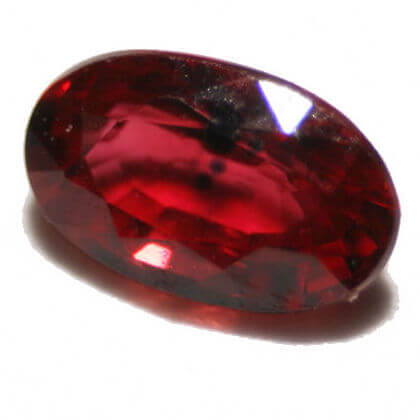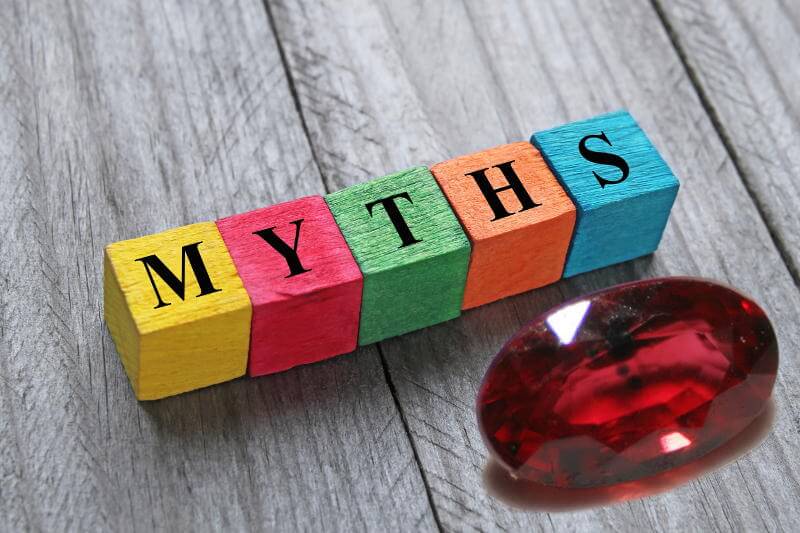July Birthstone
Crimson red rubies are July's sought after birthstones
- Home /
- Birthstones by Month /
- July Birthstone
What is The Birthstone of July?
 July Birthstone - Ruby
July Birthstone - Ruby
Rubies - The birthstone of July - hot, warm and flaming red, July’s birthstone is appropriately fiery colored. Deep shades of crimson red, the Ruby is known not only as a summery gem but also for its association with undying love, success and intense emotions.
Shrouded in the mystery of its depth, this stone’s history dates all the way back to the Bible, and is currently a prized gem, desired for its lush color and symbolism. The fact that it is close to impossible to find a large sized ruby, adds to the gem’s rarity and desirability.
Quick Facts on July's Birthstones
July Birthstone Facts
| Birthstone of July | Ruby |
|---|---|
| Birthstone Color | Red and on occasions shades of pink |
| Mohs Scale | 9 |
| Chemical Formula | Al₂O₃ |
| Origin | Myanmar (Burma), Pakistan, Sri Lanka, Afghanistan, India, Vietnam, Nepal, Australia |
Gift Ideas with July’s Birthstone - Rubies
Rubies are amongst the most expensive birthstones that are out there. In fact amongst the most expensive gemstones period. However, still, you can find amazing and dazzling gifts at affordable prices. For example, I’ve gathered below a few of the favorites I found at Blue Nile, all are under $500 (couple of the rings are even under $300)
The Story of Rubies
 Ruby Gemstone in the Rough
Ruby Gemstone in the Rough
One of the most precious gems in the world, rubies have been admired in both Western and Eastern cultures. The Ancient Hindus referred to it as “Ratnaraj”, which translates to “King of Precious Stones”, while in Ancient China the stone was dubbed as “a drop of blood from Mother Nature’s heart”. In fact, historical records indicate that rubies were traded around 200 B.C. throughout Chinas’ North Silk Road.
In Ancient India, people believed that if they would offer rubies as gifts for the Gods, the divine spirits would grant them eternal life, or would allow them to be reborn as emperors. On the other hand, in Burma during 600 AD, warriors believed it wasn’t enough to simply possess a ruby; they had to become one with the precious gems, and would find different ways to implement the stone on and under their skin.
During the Middle Ages, the rubies had become associated with the sun, strength and vitality. As a result, they were also linked to mental health and perseverance. Furthemore, the stones were assumed to have prophetic abilities, and would darken when danger lurked around the corner. For many years, rubies were also used for therapeutic and medicinal purposes; either crushed into potions alleviating liver diseases or rubbed against the skin to achieve youthfulness.
It wasn’t until the 19th century that rubies had become a prominent stone in Western royal jewelry. It was then, when experts were able to differentiate between ruby and garnet as well as other red gems such as tourmaline. Thus, they had discovered that the precious jewel was a variety of corundum and consequently related to the sapphire. Nowadays, the largest and most famous ruby is the Burmese Ruby Tiara which had been created for Queen Elizabeth.
Myths and Legends
 Ruby Birthstone Myths
Ruby Birthstone Myths
Deriving from the Latin word “Ruber”, literally meaning red, rubies have always been affiliated with flames and a fickle temper. That is perhaps also the reason they had become the ultimate gift representing eternal love. But before they became a treasured gesture of love, in the Bible, rubies were thought to be as precious as wisdom itself. In addition, the gems were used for clairvoyance - predicting disasters and offering insights about the future.
It is however, in a book from the 13th century, by George Fredrick Kuntz, that rubies, and gemstones in general, became linked to different fantasies and fairy tales. The most famous of them promotes the idea that gems can either be female or male and have feelings of their own. Specifically for rubies, Kuntz described them as formed in the flames of a dragon’s fire breath.
Inevitably amorous, eternally red - these stones will captivate your heart and warm it at the same time.

 Baguette Ruby and Diamond Pave Stacking Ring
Baguette Ruby and Diamond Pave Stacking Ring
 Bezel-Set Ruby and Diamond Bar Ring
Bezel-Set Ruby and Diamond Bar Ring
 Petite Alternating Ruby and Diamond Stacking Ring
Petite Alternating Ruby and Diamond Stacking Ring
 Marquise Ruby and Diamond Ring
Marquise Ruby and Diamond Ring